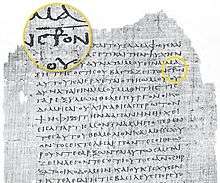Staurogram



The Staurogram (⳨), also Monogrammatic Cross or Tau-Rho,[1] is a ligature composed of a superposition of the letters tau (Τ) and rho (Ρ).
The Staurogram was first used to abbreviate stauros (σταυρός), the Greek word for cross in very early New Testament manuscripts such as P66, P45 and P75, almost like a nomen sacrum, and may visually have represented Jesus on the cross.[2]
The Tau-Rho as a Christian symbol outside its function as nomen sacrum in biblical manuscripts appears from c. the 4th century, used as a monogramma Christi alongside the Chi-Rho and other variants, spreading to Western Europe in the 5th and 6th centuries.[3]
Ephrem the Syrian (4th century) discusses a Christian symbol, apparently combining the Tau-Rho with Alpha and Omega placed under the left and right horizontal arms of the Tau. Ephrem says that the Tau represents the cross of Jesus (prefigured by the outstretched hands of Moses in Exodus 17:11), the Alpha and Omega signify that the crucified Christ is "the beginning and end", and the Rho, finally, signifies "Help" (βοήθια [sic]; classical spelling: βοήθεια), because of the numerological value of the Greek word being 100, represented by Rho as a Greek numeral.[4]
The two letters tau and rho can be found separately (not in ligature) as symbols already on early Christian ossuaries.[5] Tertullian (Contra Marcionem 3.22) explains the Tau as a symbol of salvation by identification with the sign which in Ezekiel 9:4 was marked on the forehead of the saved ones.[2] The rho by itself can refer to Christ as Messiah because Abraham, taken as symbol of the Messiah, generated Isaac according to a promise made by God when he was one hundred years old, and 100 is the value of rho.[5]:158
The staurogram is encoded by Unicode in the Coptic block, at U+2CE8 ⳨ COPTIC TAU RHO, and as of Unicode 7.0 (2014) also in the Ancient Symbols block, at U+101A0 𐆠 GREEK SYMBOL TAU RHO. The Coptic block has a ligature of the full word σταυρός, where the τρ is represented by the staurogram, and two lunate sigmas are attached to either side of the tau's horizontal bar, at U+2CE7 ⳧ COPTIC SYMBOL STAUROS.
References
- ↑ The term staurogram in this sense is of relatively late coinage (1960s); "monogrammatic cross" is in use in the later 19th century.
- 1 2 Hurtado, Larry (2006). "The Staurogram in Early Christian Manuscripts: the earliest visual reference to the crucified Jesus?". In Kraus, Thomas. New Testament Manuscripts. Leiden: Brill. pp. 207–26. ISBN 978-90-04-14945-8.
- ↑ Redknap, Mark (1991). The Christian Celts: treasures of late Celtic Wales. Cardiff: National Museum of Wales. p. 61. ISBN 978-0-7200-0354-3.
- ↑ Hurtado (2006), citing F. J. Dölger, Sol Salutis (1920), p. 61 (note 2). Ephraem in sanctam Parasceven, Ephraem Syri opera omnia quae extant graece — syriace — latine Tom. III Romae 1746, p. 477.
- 1 2 Bagatti, Bellarmino, "The Church from the Circumcision: history and archaeology of the Judaeo-Christians", Studium Biblicum Franciscanum, Collectio Minor n. 2, Jerusalem (1984).
See also
| Look up staurogram in Wiktionary, the free dictionary. |
| Wikimedia Commons has media related to Staurogram. |